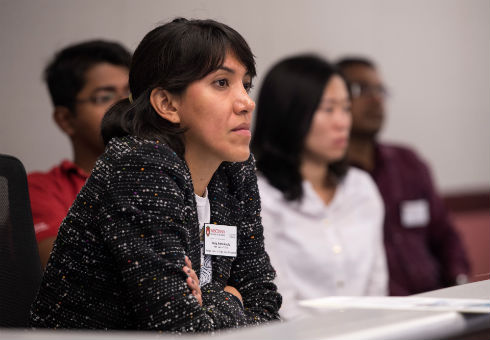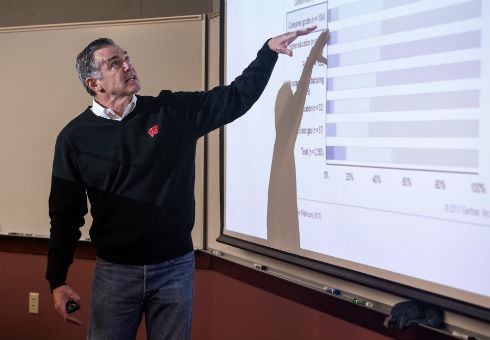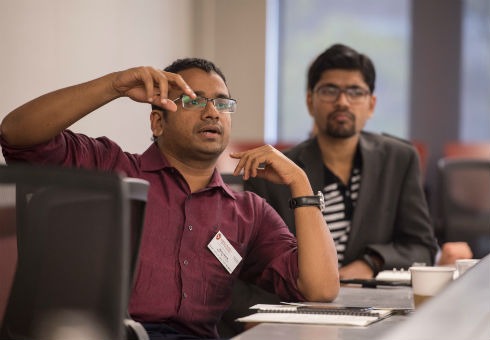
Not long ago, SCM World’s Chief Content Officer Kevin O’Marah was in London for the SCM World Leaders Forum, a prestigious summit for operation and supply chain leaders from Fortune 500 companies. After speaker and CEO Mike Gault of Guardtime, a blockchain platform provider, stepped down from the podium, he was mobbed by participants who were desperate to learn more about this emerging technology that operates by using a decentralized digital ledger.
It was a sight O’Marah won’t soon forget.
“People were literally handing out their cards,” he says of the rush for Gault’s expertise. “It was by far the most popular topic of the whole event.”
Part of the sense of urgency is that the technology is such a new frontier; a firm can’t pick up the phone and order a finished blockchain system. “Right now it’s a concept,” O’Marah says. “Everything about it is custom stitch.”
Thanks to O’Marah and Steve Loehr, vice president of global technology services at IBM, supply chain students at the Wisconsin School of Business are learning about the phenomenon at virtually the same time as the world’s top business executives. Both serve on the Grainger Center for Supply Chain Management’s Executive Advisory Board. They teamed up recently to present their blockchain findings in a special forum for WSB students about what this cutting-edge technology might mean for the supply chain industry.
In terms of its massive impact and potential for both innovation and disruption, O’Marah compares blockchain to when the internet was first surfacing. “It’s one of those technologies that isn’t so much a technology as it is a completely new way of thinking about how things get organized.”

“It was fantastic to expose our students to this new technology, especially given that two of our Executive Advisory Board members were able to come together and facilitate the discussion,” says Gregory DeCroix, professor of operations and information management and the academic director of the Grainger Center. “This was a great example of how we use our applied learning curriculum to expose students to what is relevant to today’s supply chain leaders.”
The ‘architecture’ of blockchain
IBM is a blockchain pioneer, investing in blockchain across all five of its divisions and working with more than 400 firms on exploring and building blockchain capabilities, Loehr says.
He broke down what he calls the essential “architecture” of blockchain, which is comprised of four main dimensions: a shared ledger, a set of transactions, immutability, and cryptography. How it works is a set of transactions are sent over a framework—a network—composed of open source code; there is no central database. The digital ledger is visible to all who are permissioned to see it, but it is immutable (unalterable), which makes it transparent. Information that is sent through the network is safeguarded by encryption, so that only permissioned users can see it. Similar to Twitter, Loehr says, the ledger thread or history of transaction is out there; it is visible and can’t be deleted to those who have access.
Transformative implications
In a supply chain context, according to Loehr and O’Mahr, nearly every procedure between supplier and manufacturer that uses paper can now be replaced by an electronic transaction using this digital ledger. Security and transparency are built into the process through encrypting information and limiting access to permissioned users. Even smart contracts—hiring and employment terms—can be embedded into a firm’s blockchain setup.

The implications of blockchain are far-reaching. Food recalls, for example, don’t have to turn into a multi-state crisis; the technology lets manufacturers track and trace the item in question back to its origins, or where it was contaminated along the transaction route. Blockchain also eliminates uncertainty on questions of ethics and sustainability. A gem store can prove to concerned customers that its diamonds are ethically sourced, or a grocery store can trace its grass-fed beef back to the original farm.
On the corporate side, manufacturers can widen their net of suppliers. They no longer have to rely on a supplier’s handshake and a promise that the product is ethically sourced—they can go straight to the digital stamp.
Preparing for a blockchain future
O’Marah says one of the problems for business owners is trying to predict the blockchain curve and debating when to jump in and get involved. “They’re thinking, ‘I don’t want to be so far behind this thing that somebody who is my rival is learning faster than I am. But I don’t want to be bleeding edge and have our company’s money and credibility blown,’” he says.
Regardless of timing, the emergence of blockchain is not an “if,” it’s a “when.” He recalls a meeting with a Colgate Palmolive executive who deemed blockchain “the most important technology of its time.”
Thanks to this forum, WSB students are better prepared for a blockchain future. Rahul Monie, (MBA ’19), plans on working with blockchain within a strategy and logistics department after graduation. Monie said the presentation sparked his thinking about the potential of this new technology. “Thirty years from now, what is blockchain going to be?”
Robert Stefansic, an executive advisory board member and a senior vice president with Ingredion, Incorporated, who also participated in the event, says the knowledge gleaned from the presentation is valuable for all. “As much as it’s learning for students, it’s also learning for leaders in industry. As a leader, you will have to decide how, when, and where to apply technology. What will the technology cost and how does it fit your organization’s priorities? It’s critical for students to have a minimum level of understanding in terms of application as it fits into the broader supply chain picture.”

Tags: